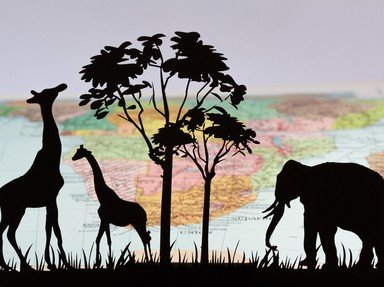Quiz Answer Key and Fun Facts
1. Much is made of the beauty of animals such as dolphins and tigers, but on the smaller scale is the dazzling yet unassuming insect that belongs to the suborder Epiprocta. If you wanted to observe this delicate, winged creature in its natural habitat, where would you hang out?
2. The insect that has species such as Duke of Burgundy, Plum Judy, and painted lady is typically nocturnal.
3. Ranging in size from 1.6 to 60 centimeters (around 5/8 inch to 24 inches), this fairly small reptile stores fat in its tail, licks its eyes to keep them clean and moist, and gets its name from an Indonesian-Malay onomatopoeic word that mimics the sound the animal makes. What sound does this creature seem to make?
4. Measuring only 55-82 millimeters (2.2-3.2 inches) long, the common shrew, found throughout northern Europe and Great Britain, is a terror to smaller creatures like insects and worms, and is one of only two terrestrial mammals known to use what means of exploring its surroundings?
5. The coachwhip is a particular species of animal, endemic to parts of North America typified by open forests or sand. Many people fear the very sight of it. How many legs does this species have?
6. One of the smaller members of the canine family, the red fox weighs around 5.9 kilograms (13 pounds) and is known for its intelligence. Female foxes are called "vixens" and baby foxes are called "kits", but what are adult male foxes sometimes called, based on a character in European folk tales?
7. The first domestic mammal to have its genome completely mapped is a medium- to large-sized ungulate, familiar as a source of dairy products, beef, and leather. Why are individuals of this group often named "Bossy"?
8. The even-toed ungulate mammal which possesses a blood pressure around twice that of humans is also known for which of these sizeable attributes?
9. The African bush elephant is the largest terrestrial mammal on Earth, and it's not pretty when one goes on a rampage. What is the name given to the period of time where a male elephant falls victim to a testosterone-fueled aggression?
10. Docile and friendly, and buoyant after being killed - as the folk etymology goes - this species got its name because it was easy to hunt, kill, and render for oil. Not the largest member of the order Cetacea, but still a really big animal, measuring up to 18 meters (59 feet) long, what species was considered the epitome of whales, once hunted almost to extinction?
Source: Author
nannywoo
This quiz was reviewed by FunTrivia editor
guitargoddess before going online.
Any errors found in FunTrivia content are routinely corrected through our feedback system.

